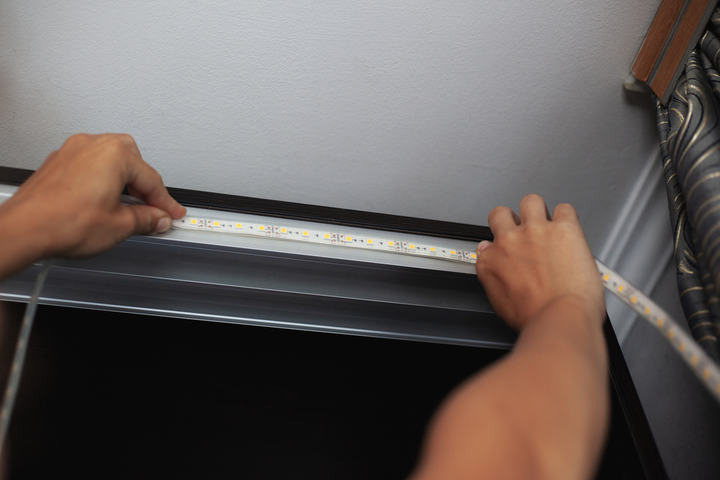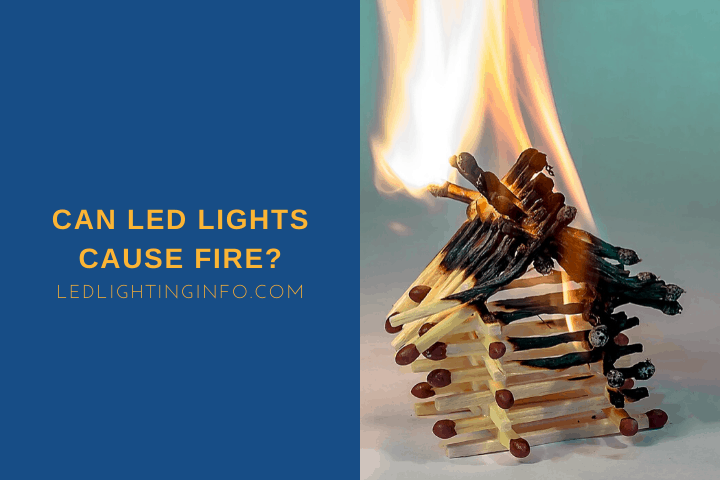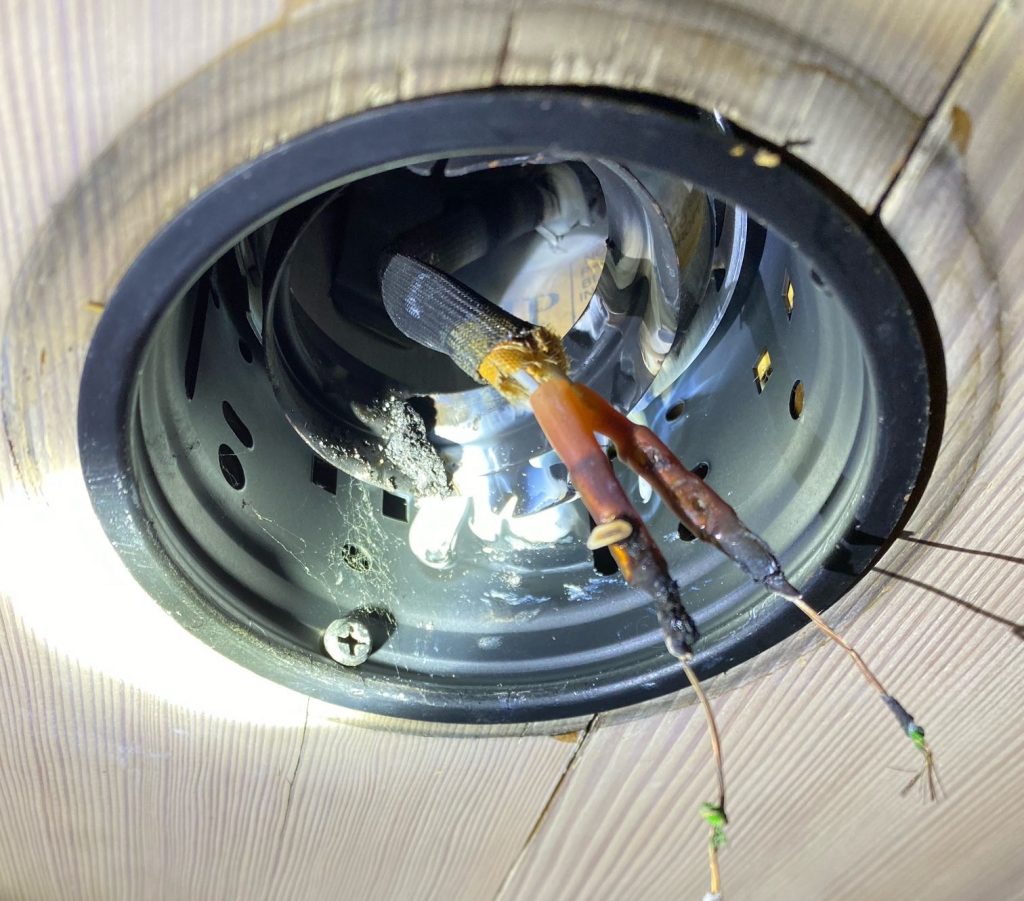Did you know that electrical problems are one of the most common causes of house fires?
Some of the most recent stats show that 15% of these fires were started by ‘lamps, light fixtures, and light.’ I’ve always looked at light bulbs as self-contained. If something is wrong, they make a popping sound, and the room goes pitch black.
Could modern LEDs be contributing to these figures?
LED lights don’t get hot enough to start a contact fire, though they do get hot to the touch. However, improper wiring and overloaded LED light fixtures are often the cause of fires. Older incandescent bulbs could get hot enough to start a fire even without these issues.
Here’s a look at the topics I’m covering in this guide:
- Whether LED lights get hot enough to start a fire
- Can LED lights cause a fire if left on overnight?
- Whether LED strip lights are a specific fire risk
Do LED Lights Get Hot Enough To Start A Fire?

When used correctly, LED lights should only reach a running temperature of around 30℃-50℃, though they can get hotter at the base of the light where the driver is – up to 80°C/176°F on average. That’s still not enough to start a contact fire with most household substances.
There are various materials used to build a home, with their own threshold for ignition. Wood has probably the lowest threshold, at around 300°C. Fiberglass insulation, as a guide, has a threshold of around 1,000°C.
So an LED bulb is never going to threaten those limits.
Traditional light bulbs – incandescent bulbs and halogen ones – can get much hotter. They average over 200°C and could get even hotter if poorly made, so they could be a risk.
LED Lights Fire Hazards
Potential fire hazards from LED lights include:
- A poorly-made heatsink, or something blocking the heat dissipation, which causes heat to build up around the driver
- Faulty wiring causes electricity to arc, which massively increases the temperature
- Incompatible bulbs and fixtures – using a high-wattage bulb in a fixture that’s designed for low-wattage lights
Each of these has a simple solution:
- Make sure you avoid buying cheap LED lights, and that you install them correctly with no foreign objects in the fixture. Also, if you’re using an enclosed fixture (e.g. inside a glass case), you only use LED bulbs designed for that purpose
- Listen and look for signs of faulty wiring – buzzing noises, or flickering lights. Once noted, check the wiring of the fixture and make sure it’s secure
- Check the fixture in your home and only use LED bulbs designed for it. Single-bulb pendant fixtures can usually handle most domestic LED bulbs but some smaller fixtures (chandeliers etc.) could have limits.
Can Leaving An LED Light On At Night Cause A Fire?
LED lights left on at night should not cause a fire. When installed correctly, in an appropriate fixture with secure wiring, they should never get hot enough to start a fire.
However, I advise you to use timers or sensors to manage the lights you wish to leave switched on – this will save you money on your utility bills and extend the lifespan of your LED lights.
For example, you can use motion sensors for your outdoor lights instead of leaving them switched on. Another apparent reason is to reduce the cost of your utility bill.
As a general rule of thumb, you should leave your lights on for 12 hours at the most to save on costs.
LED light bulbs are the safest kind of light to leave on for 24 hours at a time, especially compared to an incandescent bulb, but leaving them on accelerates their deterioration.
DISCLAIMER: Although the information in this article is accurate as possible, it is for general purposes only. You should not rely on the material as the basis for making any decisions. The author is not liable for any damage caused by lighting.
Are LED Strips a Fire Hazard?

LED strip lights are slightly more at risk of catching fire than an LED bulb, because they don’t always have a built-in heat dispersion system, and the power supply is an additional risk of overheating. However, correctly installed and with the right supply, they shouldn’t be a fire risk.
Light strips don’t get to temperatures much higher than an LED bulb.
The LED chips on a strip are smaller than a light bulb, but there are many more of them, so it balances out.
The issue is that strips are often installed in recesses or on the undersides of furniture for a cool effect, but this can hinder airflow.
Without effective heat sinks installed, the heat generated by the LED lights can build up and become a risk.
Also, people often chain an LED strip light to another, and it can be easy to accidentally overload the power supply unit. So it’s not the LED lights directly causing a fire, it can be the power supply.
It’s always important to choose a power supply with at least 20% additional capacity for the wattage of your light strips combined, so that there’s no risk of overload.
FAQ
Can LED Lights Catch Fabric On Fire?
LED lights will only cause fabrics to catch on fire if there is a fault with the wiring or the heat sink. Most fabrics ignite at temperatures of between 300℃ and 500℃, and LEDs don’t get near this temperature when working normally.
Are Smart Bulbs A Fire Hazard?
Smart bulbs are no more a fire hazard than any other kind of LED lights. They don’t get any hotter than non-smart bulbs. If anything, they are less of a risk because you can control them remotely, so you have no excuse for leaving LED light fixtures switched on even when you’re in bed or out of the house.
Can A Burned Out LED Bulb Cause A Fire?
A burned-out LED light bulb shouldn’t cause a fire. The circuit will merely be broken, which should mean that the current won’t flow. It’s still always best to remove a blown bulb from a light fixture, and replacing it with a working bulb, just for extra safety.
Can Turning Lights On And Off Cause A Fire?
Turning LED lights on and off won’t cause a fire – this doesn’t degrade the bulb. It’s only when you leave LED lights on that the temperatures can cause lights to wear out faster. With traditional bulbs, switching them on and off frequently would be more of a risk as the filaments rapidly heated and cooled.
Can LED String Lights Catch Fire?
String LED lights – such as those used as decorative and festive lights – can catch fire if they’re used with the wrong power supply. Some are designed for mains voltage (120V – these are called line voltage string lights), while some are low voltage string lights (12V or 24V), so using the right power supply is critical.
Power cord failures can also occur more easily with string lights – curious pets are known to nibble at hanging wires. This can lead to arcing electricity, which means more heat generated, which means a higher fire risk.
Final Words
LED bulbs are safe, provided they are correctly installed. Overheating is a common issue with strip lights, so be sure to take extra precautions. LED bulbs can be left switched on indefinitely, but that’s typically inadvisable.
They’re still much safer than older incandescent lights, so swapping to more modern tech is making your home safer.
Still – there’s always a tiny chance that LED lights could explode – read my guide on that if you want to know more.
Looking for an LED bulb but not sure what type you need?
Check out my free bulb picker and select the right bulb within few clicks.


